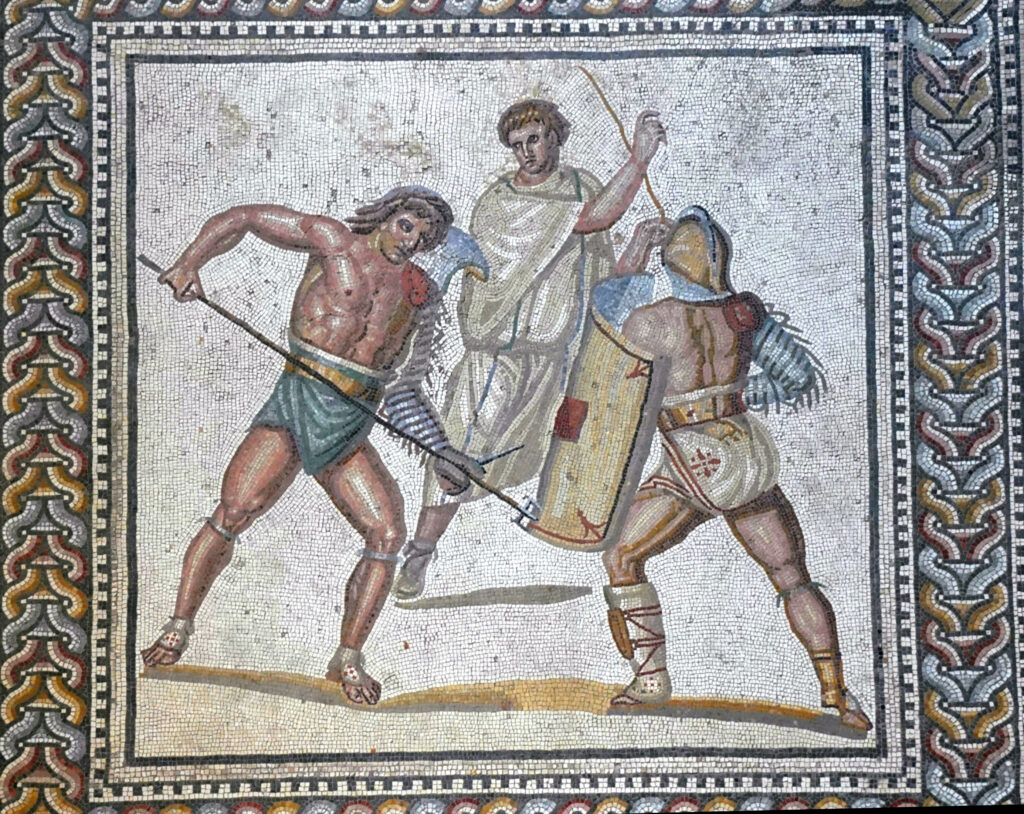In the grand arena of ancient Rome, amidst the roar of the crowds and the clash of swords, stood the formidable figures known as Roman gladiators. These skilled fighters were not just entertainers; they were symbols of courage, strength, and resilience in the face of adversity.
Who were Roman Gladiators?
Roman gladiators were trained combatants who fought in arenas called amphitheaters for the entertainment of the Roman people. They came from diverse backgrounds, including slaves, prisoners of war, and volunteers seeking glory and fame. Despite their varied origins, they all shared a common destiny: to battle against each other or wild animals in deadly contests.

A retiarius stabs at a secutor with his trident in this mosaic. Location: Nennig, Germany. Source: Wikipedia
The Life of a Gladiator
Life as a gladiator was harsh and demanding. From a young age, aspiring fighters underwent rigorous training, honing their skills in combat techniques and weaponry. They lived in barracks under strict discipline, their every move controlled by their owners, known as lanistae.
Gladiators were often branded with distinctive marks to signify their status as property. Despite these hardships, many gladiators embraced their role with pride, seeing it as an opportunity to earn wealth and adoration through their prowess in the arena.
Types of Gladiators
There were several types of gladiators, each with their own distinctive armor, weapons, and fighting styles. Some of the most famous include:
- Secutor: Known as “pursuers,” these gladiators were heavily armored and equipped with a short sword and a large shield. They often fought against retiarii, using their superior armor to withstand their opponent’s net and trident.
- Retiarius: These gladiators were known for their agility and speed. Armed with a net and trident, they relied on quick movements and cunning tactics to ensnare their opponents.
- Thraex: Modeled after Thracian warriors, these gladiators wore a distinctive helmet with a griffin crest and wielded a curved sword and a small shield. They often fought against murmillos in fierce battles.
- Murmillo: Characterized by their fish-shaped helmet and large rectangular shield, murmillos were well-armored fighters who typically clashed with thraex gladiators in epic duels.
Each type of gladiator had its own strengths and weaknesses, leading to thrilling and unpredictable matches in the arena.
Gladiator Games: Spectacles of Blood and Valor
The gladiator games, known as munera, were among the most popular forms of entertainment in ancient Rome. Held in massive amphitheaters such as the Colosseum, these spectacles drew huge crowds eager to witness the excitement and drama of combat.
The games were often accompanied by elaborate ceremonies and rituals, with the emperor or other high-ranking officials presiding over the proceedings. Gladiators would enter the arena to the cheers of the crowd, their fate hanging in the balance as they prepared to face their opponents.
The Legacy of Roman Gladiators
Despite their brutal and often deadly nature, the gladiator games left a lasting impact on Roman society and culture. They served as a reflection of the values of the time, glorifying concepts such as courage, honor, and sacrifice.
The image of the gladiator has endured through the centuries, capturing the imagination of artists, writers, and filmmakers around the world. Today, the legacy of these legendary fighters lives on in popular culture, reminding us of the power of human endurance and the thrill of victory in the face of overwhelming odds.